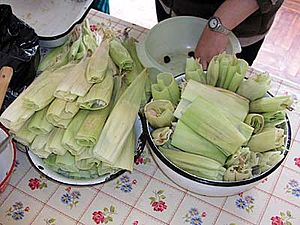Humita
Humita is a Native South American food. A traditional food from the Andes, it is eaten in Bolivia, Chile, Ecuador, Peru and Argentina. It is made from fresh choclo (Peruvian maize). It is pounded to a paste, wrapped in a fresh corn husk, then slowly steamed or boiled. In Bolivia, it is known as huminta and in Brazil as pamonha. Humitas are like Mexican uchepos, or tamales colados, which are also made with fresh corn; but they are not like tamales, which are made with masa.
 | |
| Place of origin | Andean states |
|---|---|
| Main ingredients | Maize, maize husk |
| Variations | Multiple |
In Argentina
changeIn Argentina, humitas are made with sautéed onions, pumpkin, and some spices. The dough is wrapped in corn husks and boiled or it is cooked in a big pan and served in bowls. Diced cheese is often added to the dough, usually queso fresco. They can be found in restaurants and markets in the north of Argentina.[1]
In Chile
changeIn Chile they are made with onion, basil, and butter or lard.[2] They are wrapped in corn husks and baked or boiled.[2] They may have green chili pepper. The humitas are tied with thread or twine to keep them together while cooking.[2] They can be made savory, sweet, or sweet and sour, and served with sugar, chili pepper, salt, tomato, olives, paprika, etc.[2] I They have been eaten in Chile since the 19th century.[3]
In Ecuador
changeEcuadorian humitas are made with fresh ground corn and onions, eggs, pork fat and spices. The dough is wrapped in a corn husk. It is steamed not baked or boiled. It may have cheese. This dish is so traditional in Ecuador that they have special pots just for cooking humitas. Ecuadorian humitas can be salty or sweet. It is common to fry them in a pan just before eating.[4]
In Peru and Bolivia
changeIn the central Andes region, humitas are made with lard and salt and queso fresco, or, sometimes, anise, for a savory dish . For a sweet dish they are cooked with lard, sugar, cinnamon and raisins
One of the earliest references to huminta in Peru was written by the Inca Garcilaso de la Vega in his book Comentarios Reales de los Incas, published in Lisbon in 1609. He describes his own memories of eating humita while he was living in Peru between 1539 and 1560..[5]
References
change- ↑ Brooks, Shirley Lomax (2003). Argentina Cooks!: Treasured Recipes from the Nine Regions of Argentina. Hippocrene Books. ISBN 978-0-7818-0997-9.
- ↑ 2.0 2.1 2.2 2.3 Chef Adds New Zest At La Pena Center, Kim Severson, San Francisco Chronicle, 06-08-1999, access date 05-12-2012
- ↑ Pereira Salas, Eugenio (1977). Apuntes para la historia de la cocina chilena. Santiago de Chile: Imprenta Universitaria. p. 11.
- ↑ Foley, Erin; Jermyn, Leslie; Paley, Caitlyn (2016-04-15). Ecuador: Third Edition. Cavendish Square Publishing, LLC. ISBN 978-1-5026-1701-9.
- ↑ de la Vega, Garcilaso (1688). Comentarios Reales de los Incas [The Royal Commentaries of Peru]. Translated by Rycaut, Sir Paul. London: M. Flesher. p. 318.
Other websites
change- The dictionary definition of humita at Wiktionary